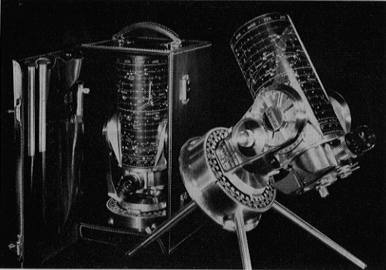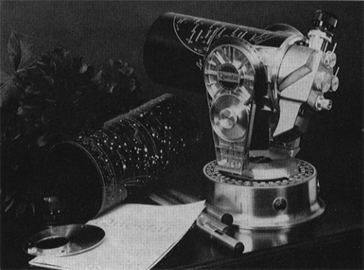Questar Distribution
![]() News
News ![]() Notes & Interesting Articles
Notes & Interesting Articles ![]() Overview
Overview ![]() Pricing
Pricing ![]() Products
Products ![]() Service or Repair
Service or Repair
Questar Telescopes ![]() LD Surveillance Systems
LD Surveillance Systems ![]() LD Microscopes
LD Microscopes ![]() Accessories
Accessories


Subject: "Distinctive Features" appeared in advertising of January 1956, this is extracted from the Questar booklet.
The booklet is no longer available, the photo captions were added by Company Seven.
 Above: Questar Standard telescope of 1956 stored in leather carrying case, and at right in Polar Aligned mode on tabletop tripod (84,404 bytes). |
Reprinted from the Questar booklet. More will follow in succeeding advertisements. The entire booklet is available upon request.
DISTINCTIVE FEATURES
If people exclaim at Questar's handsome appearance, that is because it is designed simply and in the tradition of functional utility. Conceived as an instrument for quick, convenient use, it becomes naturally an object for adornment of desk or table. Its color scheme was kept to deep blue and silver with that in mind. Its metals are honestly engine-turned, in variety of texture and polish.
The gem-like depth of color in Questar's patented star chart and moon map is due to the surface treatment of the metal. These maps, like the large circle, and name plates, are anodized by the electrolytic process which changes the surface of the polished metal into a layer of clear, hard, transparent aluminum oxide, a kind of corundum or sapphire. This protective coating has sub-microscopic pores which accept translucent dyes. The metal is engraved by etching through the anodized surface, and the sunken areas or lines are filled with colored enamels.
Some 340 stars are shown in six sizes to indicate stars larger than the fifth magnitude. The three brightest stars of each constellation are designated by their respective Greek letters. Turning the star chart, to match the earth's rotation, reveals the constellations as they rise, while hiding others as they sink below the horizon. Thus the stars on the other side of the chart correspond to those hidden by the earth. The chart gives accurate positions by hour angle or right ascension and in degrees of declination.
No longer need the observer hold complex star charts at arm's length overhead and face in various directions. Questar's chart takes the place of twelve because its rotating feature eliminates the need for a separate chart for each month. In use, Questar is simply pointed south, whereupon the observer, while comfortably seated, may identify objects by comparison with the chart. The amount of data, its scales and color contrast, have been carefully chosen for maximum readability in dim light. Because the planets move, they, of course, cannot be shown upon the chart.
The star chart slips forward to become a dewcap, guarding the front lens against fogging on those moist nights when glass or metal objects, like automobiles for example, radiate their heat and become covered with dew. Under the star chart is a large map of the moon sheathing Questar's tube. All parts of the lunar chart can be examined because the whole telescope tube is rotatable about its axis in the mounting. The eyepiece may be inclined at will, a feature of the greatest convenience in so versatile an instrument.
The barrel is supported wholly at its rear closure by Questar's patented double-U form of fork mounting. One side arm carries the declination slow motion and the other the clamp in declination. The knobs are of two sizes for recognition by feel in the dark, and are hollowed for lightness.
An important innovation is the patented Questar method of mounting the primary mirror on a thimble passing through its perforated center, with plastic shims to keep the glass away from heat-conducting metal. Aside from this support, the mirror is free-standing in air, with consequent mechanical and thermal stability. The long thimble is dry-lubricated, and free to slide along a stainless steel tube, permitting Questar to focus from infinity to the unheard-of short distance of only 7 feet, by moving the thimble and mirror only three-quarters of an inch. Without this ingenious method of internal focussing, we should be obliged to move the eyepiece through a distance of several feet to achieve a similar range.
Another unique innovation is the built-in finder, which projects a clear, sharp, wide-field low-power view into the single fixed eyepiece whenever the main erecting prism is thrust aside by its actuating lever. Thus a finger-flick at any time brings either system's image to the eyepiece. The user never has to grope in the dark for a finder eyepiece and stand practically on his head to use it. At choice, or for the most exacting work, the eyepiece may be used without the erecting prism, in the main optical axis. In this form Questar is sharpest, and the image is inverted in the conventional astronomical manner.
Among the vital refinements built into Questar that transform long hours of observing from drudgery into relaxed pleasure are the rotary controls and finger-flick levers. Slow motion knobs are completely without backlash, and are designed to work for a century without adjustment. The rotary focussing knob runs in nylon threads, and indicates the point of focus by its own position.
Questar's two small levers both actuate and indicate in darkness by the user's sense of touch. The side lever at the right controls the prism, as previously mentioned. The top lever causes an achromatic negative lens to swing into place which doubles eyepiece power when desired. Those who have tried to squint through the tiny lenses of conventional high-power eyepieces will especially appreciate this modern amplifying lens, which extends Questar's effective focal length from 42 to 84 inchesa full seven feet-permitting use of the superior larger eyepieces, whose higher eye-points make them more comfortable to use, particularly by those who wear eyeglasses.
Thus, two more innovations result from Questar's basic concept of merging telescope and accessory, of the finger-tip control of auxiliary optical elements built right into the instrument-Questar has two focal lengths, and each eyepiece has three powers instead of only one.
All these built-in features that set Questar apart are genuine advances in conception and design, calculated to make the use of the instrument an unfailing pleasure.
Many advanced engineering features are not visible to the eye, such as the lavish use of nylon bearing surfaces for the finest, smoothest turning, and to insure that no lubrication should be required for periods of many years. Not obvious at first sight is the system of convenient and safe clutches for quick motion. Not evident at once is the doublysealed gear train of the synchronous electric drive, perhaps the simplest ever built into any telescope. It is so devised that once started, there is no lost motion at all throughout repeated settings. The sealed oilfilled motor is the finest available and incorporates a special winding and a special non-magnetic internal shield to eliminate heat. It runs on 60 cycle 115 volt alternating current.
To insure against corrosion, Questar's fastenings are of stainless steel, the strongest and most costly engine turned screws procurable being used.
To demonstrate Questar, one need not wait for night or clear skies. The perfect clarity and enormous magnification of the telescope may be shown anywhere at any time, even in the smallest of rooms. We need only make sure that the test objects are extremely well illuminated, so that the image does not become too dim with enlargement. The solar filter may be demonstrated on a white hot lamp filament just a few feet away.
It is very rewarding to show Questar to the old-timers, the real optical experts, and feel their pleasure. Mr. A. G. Ingalls, who as an editor of the Scientific American, is the dean and patron saint of amateur astronomers and who has recently had a crater on the moon named in his honor, said this: "Questar is a little gem, and you know very well I never say such things lightly." TO BE CONTINUED
 Above: Questar Standard telescope of 1956. Shown at the side are Tabletop Tripod Legs, Off Axis Solar Filter, and Dew Shield at left (59,059 bytes) |
Contents Copyright 1956-2000 Company Seven and Questar Corp. All Rights Reserved

